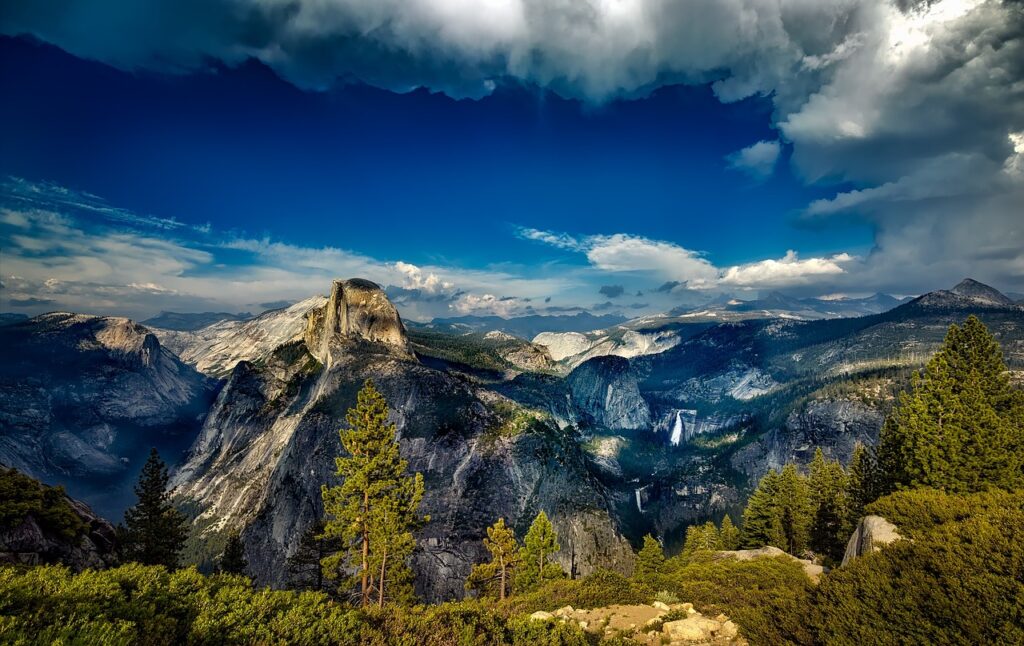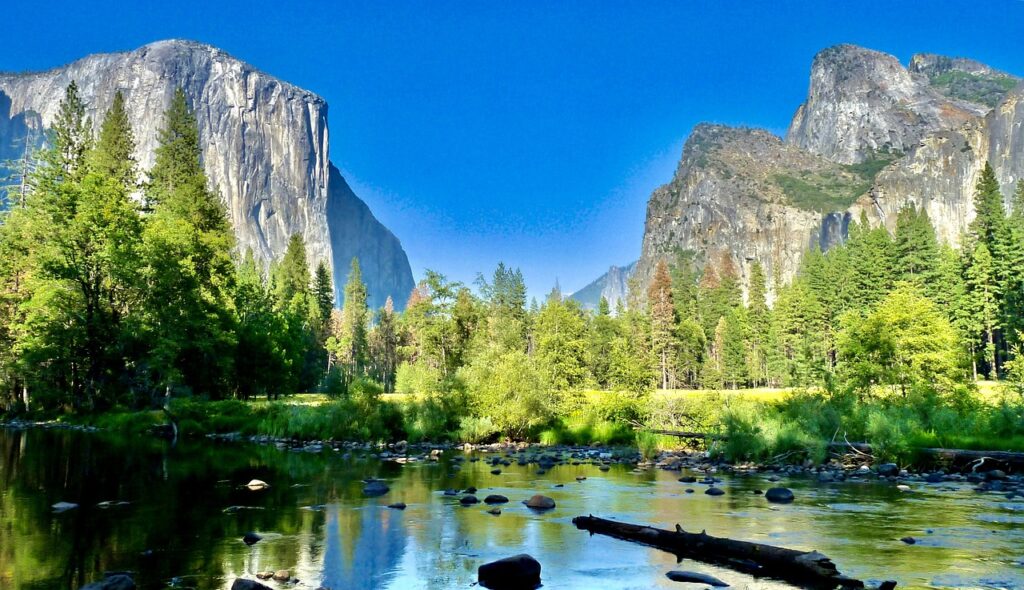Nestled in California’s Sierra Nevada mountains, Yosemite National Park is a paradise for outdoor lovers. From dramatic granite cliffs and towering waterfalls to ancient sequoia trees and lush meadows, the park offers something for everyone. Whether you have just one day or four, this guide will help you make the most of your time in Yosemite.

Day 1: Discovering Yosemite Valley
Yosemite Valley is the crown jewel of the park and a must-see destination, even if you only have one day to explore. Begin your adventure early in the morning to avoid crowds and make the most of your time.
1.1. Tunnel View Your first stop should be Tunnel View, one of the most iconic viewpoints in Yosemite. As you drive into the park on Highway 41, you’ll encounter this breathtaking vista, offering sweeping views of El Capitan, Half Dome, and Bridalveil Fall. This view is especially stunning at sunrise when the soft light illuminates the valley.
1.2. Bridalveil Fall Next, head to Bridalveil Fall, a short 0.5-mile round-trip hike that leads to the base of the 620-foot waterfall. The mist from the falls creates a cooling effect, making it a perfect morning stop. In spring and early summer, the waterfall is at its most powerful.
1.3. Yosemite Falls After Bridalveil, head toward Yosemite Falls, one of the tallest waterfalls in North America at 2,425 feet. You can opt for the easy 1-mile loop to the base of the lower falls or take the more strenuous 7.2-mile round-trip hike to the top of the falls for an unparalleled view of the valley.
1.4. El Capitan & Half Dome No trip to Yosemite is complete without seeing the famous granite cliffs of El Capitan and Half Dome. Drive along Northside Drive for close-up views of these natural wonders. If you’re lucky, you may spot rock climbers scaling El Capitan’s imposing 3,000-foot face.
1.5. Picnic at Sentinel Meadow For lunch, head to Sentinel Meadow, where you can enjoy a picnic with incredible views of Yosemite Falls and the surrounding valley. This is a great spot to relax, recharge, and take in the beauty of the park.
1.6. Ansel Adams Gallery & Yosemite Museum In the afternoon, visit the Ansel Adams Gallery, where you can admire and purchase photographs from the famous landscape photographer who captured Yosemite’s beauty. The nearby Yosemite Museum offers exhibits on the park’s history and Native American culture.
1.7. Mirror Lake End your first day with a visit to Mirror Lake. This 2-mile round-trip hike offers a peaceful, scenic walk to a reflective pool with stunning views of Half Dome. The lake is seasonal, so the best time to visit is in spring or early summer when it’s filled with water.
Day 2: Glacier Point and the Mariposa Grove
With an extra day, you can venture outside Yosemite Valley to explore some of the park’s other stunning landscapes.
2.1. Glacier Point Start your second day with a drive up to Glacier Point, a 45-minute journey from Yosemite Valley. The viewpoint offers jaw-dropping panoramic views of Half Dome, Yosemite Falls, and the High Sierra. If you’re feeling adventurous, consider hiking the Four-Mile Trail, a strenuous 9.6-mile round-trip hike that leads from the valley floor to Glacier Point. The reward? Unforgettable views of the entire valley.
2.2. Sentinel Dome and Taft Point If you want to avoid the crowds at Glacier Point, opt for a shorter, less-crowded hike to Sentinel Dome and Taft Point. This 2.2-mile round-trip hike offers panoramic views from the top of Sentinel Dome, while Taft Point provides a dramatic overlook with sheer drop-offs and breathtaking vistas of the valley below.
2.3. Mariposa Grove of Giant Sequoias In the afternoon, head to Mariposa Grove, home to over 500 giant sequoias, some of the largest and oldest trees on Earth. A visit to this grove is a humbling experience, especially when you stand beside the Grizzly Giant, a sequoia that’s estimated to be over 2,000 years old. You can take the easy 2-mile Grizzly Giant Loop or, if you have more time, the 7-mile round-trip Mariposa Grove Trail to see more of these majestic trees.
2.4. Wawona Hotel End your day with a visit to the historic Wawona Hotel, a beautiful Victorian-style hotel built in 1876. Enjoy a relaxing evening on the porch, take a dip in the swimming pool, or have a quiet dinner at the hotel’s restaurant before heading back to Yosemite Valley or your accommodation.

Day 3: Hiking the Mist Trail and Exploring Tuolumne Meadows
With three days in Yosemite, you can embark on one of the park’s most famous hikes and explore the stunning Tuolumne Meadows.
3.1. Mist Trail to Vernal and Nevada Falls The Mist Trail is one of Yosemite’s most popular hikes, and for good reason. The 7-mile round-trip hike takes you past Vernal Fall and Nevada Fall, two of the park’s most spectacular waterfalls. The trail is steep and strenuous, but the views are worth it. Be prepared to get wet, especially in the spring when the waterfalls are at their peak. If you’re not up for the full hike, you can turn back after reaching the top of Vernal Fall for a shorter, 3-mile round-trip hike.
3.2. Tuolumne Meadows In the afternoon, head to Tuolumne Meadows, a 90-minute drive from Yosemite Valley. This high-elevation meadow is a serene and less-crowded part of the park, offering stunning views of the surrounding granite domes and peaks. Take a leisurely walk through the meadows or opt for a more challenging hike to Lembert Dome or Cathedral Lakes.
3.3. Tenaya Lake On your way back to the valley, stop at Tenaya Lake, a crystal-clear alpine lake surrounded by granite peaks. This is a great spot for a swim or a paddle in the summer months. You can also take a leisurely stroll along the lake’s shoreline.
Day 4: Tioga Pass and Beyond
If you’re lucky enough to have four full days in Yosemite, dedicate your last day to exploring the high country along Tioga Road.
4.1. Olmsted Point Your first stop along Tioga Road should be Olmsted Point, a scenic overlook with views of the back side of Half Dome and the surrounding wilderness. It’s a short walk from the parking area to the viewpoint, making it a great place to stretch your legs.
4.2. May Lake Next, take a short detour to May Lake, a peaceful alpine lake that’s easily accessible via a 2.4-mile round-trip hike. The trail offers stunning views of Mount Hoffmann and is less crowded than many of the valley’s hikes.
4.3. Mono Lake If you’re up for a longer drive, continue east on Tioga Road to Mono Lake, a unique and otherworldly landscape located just outside the park. The lake is known for its bizarre tufa towers, which rise from the water like natural sculptures. A visit to Mono Lake offers a stark contrast to the lush greenery of Yosemite.
4.4. Return to Yosemite Valley End your final day back in Yosemite Valley, where you can enjoy a sunset walk or take in one last view of the valley’s iconic landmarks.
Where to Stay in Yosemite
Yosemite offers a range of accommodation options, from luxurious hotels to rustic campgrounds. Here are a few of the top choices:
- Ahwahnee Hotel: Yosemite’s most iconic hotel, offering luxury accommodations and stunning views of Half Dome and Yosemite Falls.
- Yosemite Valley Lodge: A more budget-friendly option located near Yosemite Falls, perfect for families and those looking for easy access to the valley’s attractions.
- Curry Village: A great option for budget travelers, offering tent cabins, standard cabins, and motel rooms in the heart of Yosemite Valley.
- Campgrounds: If you prefer to camp, Yosemite has several campgrounds, including North Pines, Upper Pines, and Lower Pines in Yosemite Valley, and Tuolumne Meadows Campground in the high country.
Best Time to Visit Yosemite
Yosemite is a year-round destination, but the best time to visit depends on your interests.
- Spring (April to June): This is the best time to see the park’s waterfalls at their peak, as snowmelt fuels the rivers and streams. Wildflowers also begin to bloom in the meadows.
- Summer (July to August): Summer is the busiest time of year in Yosemite, with warm weather, clear skies, and all roads and trails open. However, it can be crowded, so plan to arrive early or visit less popular areas of the park.
- Fall (September to November): Fall offers cooler temperatures and fewer crowds, making it a great time to visit. The park’s trees also put on a stunning display of fall colors.
- Winter (December to March): Yosemite transforms into a winter wonderland in the colder months, with snow covering the valley and opportunities for snowshoeing, cross-country skiing, and ice skating.
Tips for Visiting Yosemite
- Start Early: Yosemite is a popular destination, especially in the summer, so plan to start your day early to avoid crowds.
- Pack Layers: Weather in Yosemite can be unpredictable, especially in the high country. Be sure to pack
If you’re planning to explore Yosemite and want to make the most of your trip, be sure to check out more detailed guides and itineraries on my website, Travel Jotters. Whether you’re looking for expert tips on hiking, the best places to stay, or hidden gems within the park, Travel Jotters has everything you need to plan your perfect Yosemite adventure. Happy travels!











